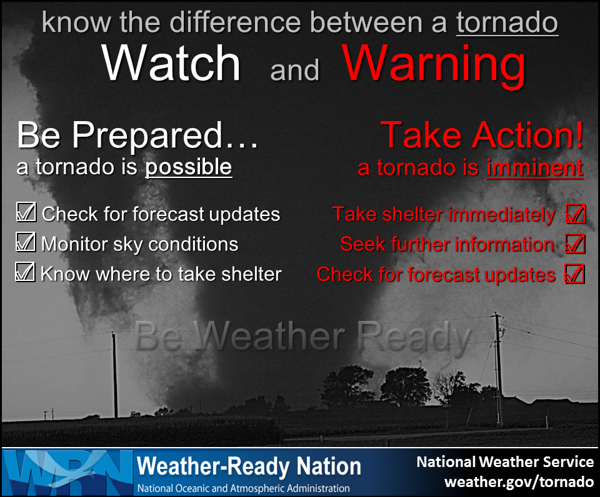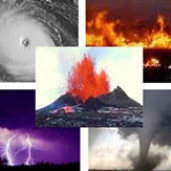
Most of us have seen a tornado on the news and the Internet, but a vast majority of people have never personally witnessed the power and destruction of a twister.
The U.S. averages about 1,200 tornadoes a year and Canada is ranked #2 in volume of tornadoes (averaging about 80 per year) with several high risk areas mostly in central provinces.
Nearly 3/4 of the world’s tornadoes occur in the U.S. annually with a majority of them touching down in “tornado alley” across the central U. S.
But keep in mind tornadoes can occur anywhere in the U.S. — with sightings in all 50 states — and across every continent except Antarctica.
Did you know…
- even though the National Weather Service (formerly called the Weather Bureau) has been tracking storms since 1870 … they were not allowed to use the word tornado in its forecasts for fear of panic until 1950..?!
- According to NOAA, 2004 had a record 1,817 tornado reports in the U.S.
- In 1974, during a 21-hour period, 148 tornadoes ripped through 13 states and 1 province between Alabama and Ontario, Canada killing 315 people.
- Tornadoes can last for several seconds or more than an hour, but most last less than 10 minutes.
- Peak tornado season in the southern states is March through May; in the northern states, it is late spring through early summer, but tornadoes can happen at any time of the year. Also, tornadoes can also happen at any time of day or night, but most tornadoes occur between 4–9 p.m.
- The 1925 Tri-State Tornado rode a straight-line path for 3.5 hours across 219 miles of Missouri, southern Illinois and Indiana, making it the longest single tornado track anywhere in the world. With a mile-wide diameter it looked wider than it was tall and caused 695 deaths — a U.S. record for a single tornado — and injured thousands.
- A waterspout is a tornado over water but isn’t recorded until it hits land.
- The force of a tornado can strip asphalt chunks off roads, rip clothes off people and pluck feathers off chickens.
Tornado basics
According to the National Severe Storms Laboratory tornadoes are rare and unpredictable, but NSSL admits experts don’t fully understand how tornadoes form.
Basically a tornado is a narrow, violently rotating column of air that extends from the base of a thunderstorm to the ground. Because wind is invisible, it is hard to see a tornado unless it forms a condensation funnel made up of water droplets, dust and debris. Tornadoes are the most violent of all atmospheric storms.
The most destructive and deadly tornadoes occur from supercells, which are rotating thunderstorms with a well-defined radar circulation called a mesocyclone. (Supercells can also produce damaging hail, severe non-tornadic winds, unusually frequent lightning, and flash floods.)
Tornado formation is believed to be dictated mainly by things which happen on the storm scale, in and around the mesocyclone.
Below topic appears in USFRA's Family Preparedness and First Aid PDF ebook - Learn more
The Enhanced Fujita (EF) scale classifies tornadoes based on 28 Damage Indicators to more accurately estimate wind speeds:
EF0 65-85 mph Light damage: Peels off some roofs; some damage to gutters or siding; broken branches, etc.
EF1 86-110 mph Moderate damage: Strips surface off roofs; mobile homes overturned; broken windows, etc.
EF2 111-135 mph Considerable damage: Roofs/mobile homes destroyed; trees snap; light-object missiles generated, etc.
EF3 136-165 mph Severe damage: Roofs/walls ripped off sturdy homes; trees debarked; heavy cars lifted & thrown, etc.
EF4 166-200 mph Devastating damage: Well-constructed homes leveled; cars thrown; small missiles generated, etc.
EF5 >200 mph Incredible damage: All homes leveled and swept away; car-sized missiles fly thru air over 109 yards; structural damage to high-rises, etc.
Most injuries or deaths caused by tornadoes are from collapsing buildings, flying objects, or trying to outrun a twister in a vehicle. Tornadoes can also produce violent winds, hail, lightning, rain and flooding.
BEFORE A TORNADO:
Learn the buzzwords - Learn the terms / words used with tornado threats...

Learn risks - Ask local emergency management office about threats in your area, what the warning signals are, and what to do when you hear them.
Where am I? - Make sure your kids know what county or area you live in and listen for that name on radio or TV updates.
Get tuned in - Keep a battery-operated radio (with spare batteries) handy for weather forecasts and updates. (NOAA’s Weather Radio has tone-alert features that alert you when a Watch or Warning has been issued.)
Be ready to evacuate - If officials say leave - DO it! (see EVACUATION)
Make a plan - Develop a Family Emergency Plan and Disaster Supplies Kit.
Learn to shut off - Know where and how to shut off electricity, gas and water at main switches and valves -- ask local utilities for instructions.
Where do I go? - Know locations of shelters where you spend time (schools, nursing homes, office, etc.) The best place is underground (like a basement, a safe room, or storm cellar) or find a hallway, bathroom, or closet in middle of building on the lowest floor.
Do drills - Practice going to shelter with your family and “duck and cover” (use your hands and arms to protect head and stay down low).
Put it on film/chip/drive - Either take videos or pictures of home and personal belongings and store them off-site with your important papers.
DURING A TORNADO WATCH OR WARNING:
Review above tips and...
Listen - Keep up with local news reports tracking the twister or conditions using a battery-operated radio.
Watch & listen - Some danger signs of a tornado include dark green-ish sky, clouds moving to form a funnel, large hail, or loud roar (like a train).
Be ready to evacuate - Keep listening to authorities - if told to leave, DO it (esp. if you live in a mobile home or trailer).
DURING A TORNADO:
Listen - Use a battery-operated radio to hear reports tracking the twister.
Take cover - If you hear or see a tornado coming take cover immediately!
IF IN A TRAILER OR MOBILE HOME – GET OUT!!!
- Get to a stronger shelter… or …
- Stay low to ground in a ditch and cover head with hands.
- If you hear or see water in the ditch, move quickly to a drier spot (in case lightning strikes nearby).
IF INDOORS - Get to a safe place right away - and avoid windows!!
- In house or small building - Go to basement, storm cellar or middle of building on lowest floor (bathroom, closet or hallway). Get under something sturdy or put mattress or covers over you for protection & stay until danger passes.
- In a school, nursing home, factory or shopping center - Go to designated shelter areas (or interior hallways on lowest floor) -- stay away from open areas.
- In a high-rise building - Go to a small, interior room or hallway on lowest floor possible and avoid windows.
IF OUTDOORS - Try to take shelter in a basement or sturdy building. Or lie in a dry ditch with hands covering your head, but watch and listen for flooding and be aware you’re a bigger target for lightning. And if you hear or see water, move since it can carry lightning’s electrical charge!
IF IN A VEHICLE - GET OUT and take shelter in a building or lie flat in a ditch with hands covering head (but be aware you’re a bigger target for lightning when lying flat & listen for flooding!) DO NOT try to out-drive a tornado! You never know which direction one will go & it moves too fast.
AFTER A TORNADO:
Listen - Use a battery-operated radio to hear reports in case there are more twisters.
Be aware - Watch for broken glass and downed power lines .. and avoid damaged buildings or homes until authorities give the OK to enter.
Injured people - Do not try to move injured people unless they are in danger and call for help immediately.
What to wear - Use sturdy work boots and gloves.
Learn more in below educational video by TWC’s Jim Cantore and download a free 68-page portion of our USFRA Family Preparedness Guide here

